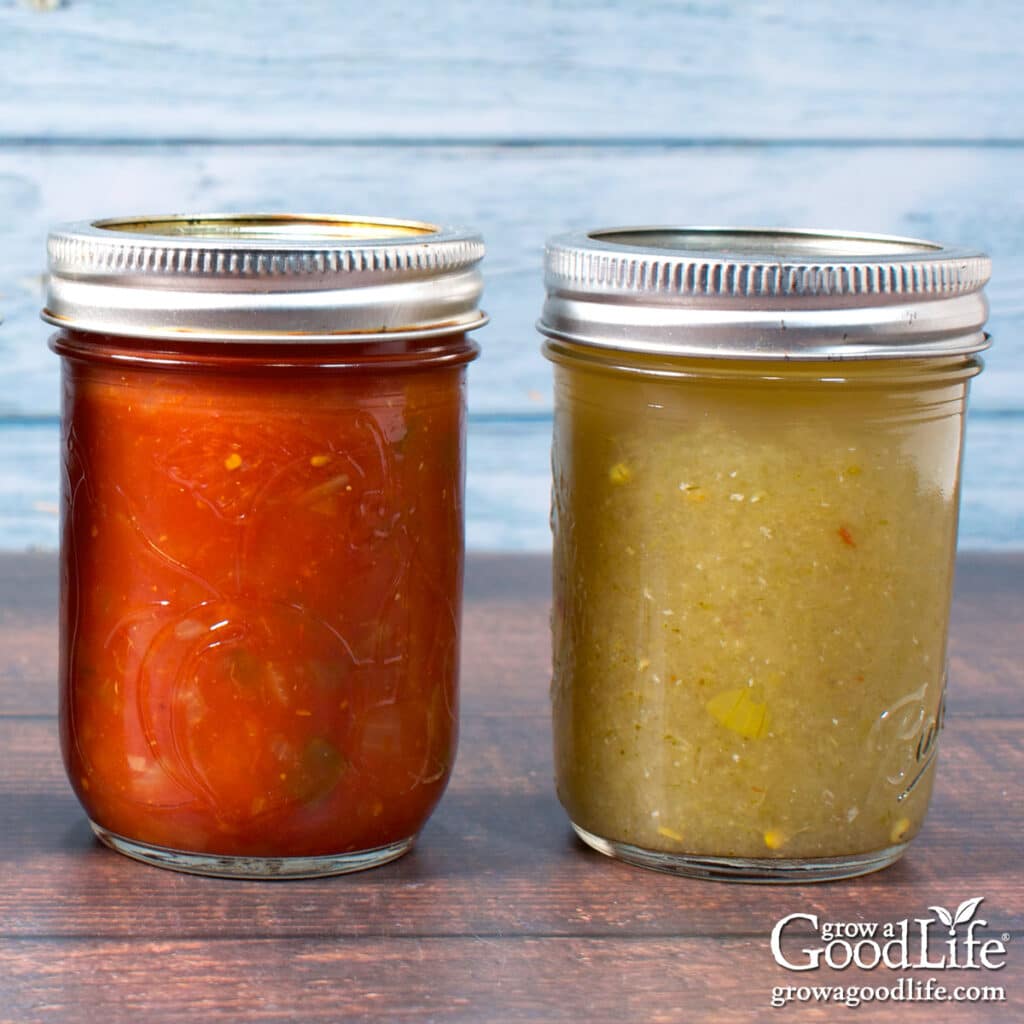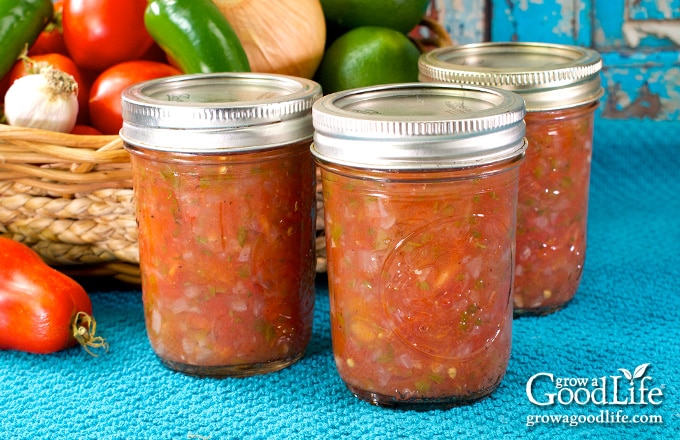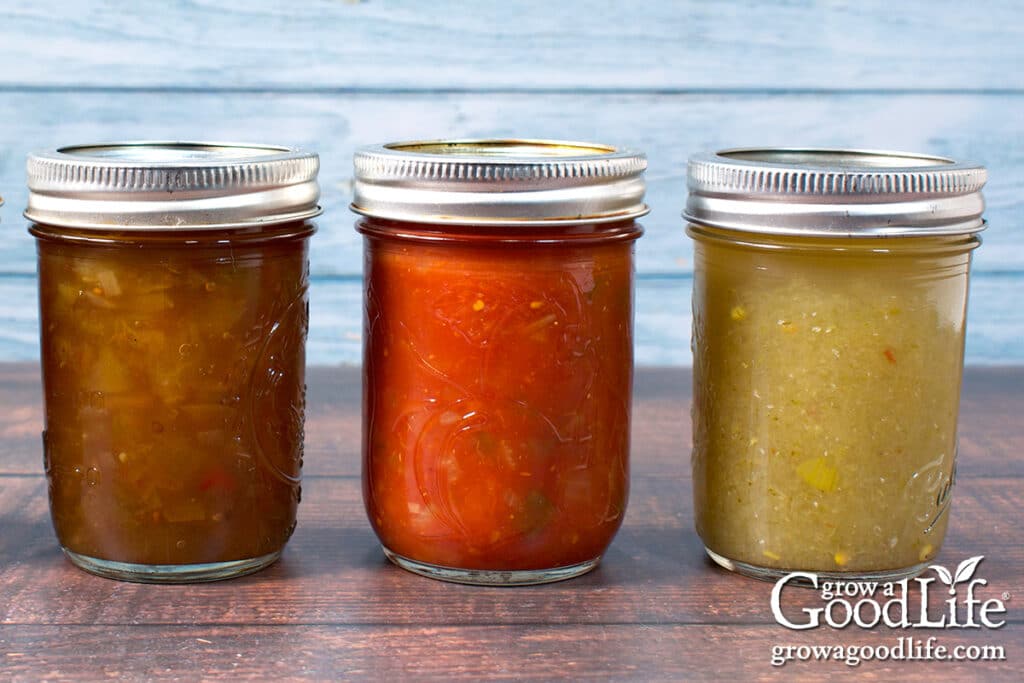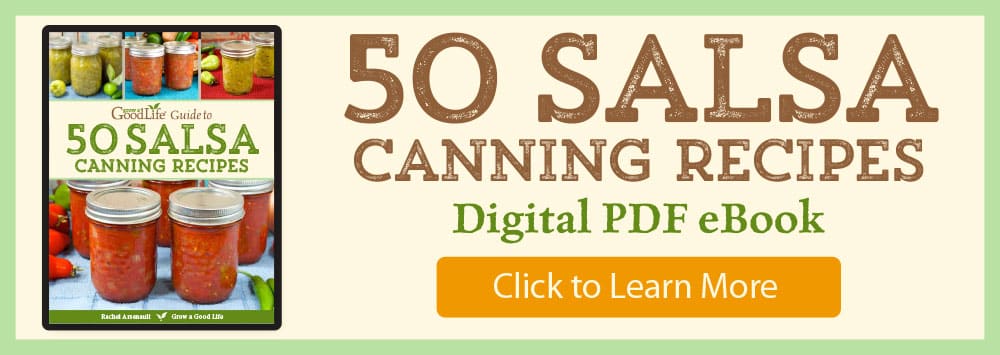Safe Adjustments for Canned Salsa Recipes
This post may contain affiliate links, which means that I may receive a commission if you make a purchase using these links. As an Amazon Associate I earn from qualifying purchases.
Wondering if you can change the ingredients in your salsa canning recipe? Learn how to make safe adjustments when canning salsa at home. Discover which ingredients you can modify and which you can’t based on tested, research-backed guidelines for safe home canning.

Home canned salsa is a delicious way to preserve the harvest and enjoy bold flavors all year long. But because salsa combines both high-acid and low-acid ingredients, it’s important to follow tested canning recipes to ensure your salsa is safe for shelf storage.
The good news? If you’re using a tested salsa recipe from a reliable source, there are still plenty of ways to safely customize the flavor to suit your tastes. From swapping pepper varieties to adjusting spices, you have room to get creative without compromising safety.
In this article, we’ll explore what kinds of ingredient adjustments you can make to salsa canning recipes, which changes should be avoided, and a few helpful tips to ensure the best results while keeping your canned salsa delicious and safe for your food storage shelves.
This article is part of our guide to safely modifying home canning recipes. For a wider range of substitutions, please visit our page on Safe Changes and Substitutions in Home Canning Recipes.
Why Safety Matters
Salsas may seem like simple mixtures of garden-fresh ingredients, but from a food preservation perspective, they’re one of the trickier recipes to can safely. That’s because they combine high-acid ingredients, like tomatoes and vinegar, with low-acid vegetables, such as peppers, onions, and garlic, and then water bath canned for safe shelf storage. If the balance of these components is altered, it can lower the overall acidity of the salsa, creating an environment where harmful bacteria can thrive.
Safe canning recipes are carefully lab-tested to ensure the final product reaches the necessary acidity and temperature to destroy pathogens during processing. Even small changes to ingredient amounts, preparation methods, or jar sizes can throw off that balance and make the salsa unsafe for home canning.
That’s why following a lab-tested salsa recipe from a reliable source, such as the National Center for Home Food Preservation (NCHFP), Ball, or university extensions is important.
Once you have a trusted recipe in hand, there’s still some flexibility to make minor tweaks for flavor, so long as those changes fall within safe guidelines. In the next section, we’ll explore which adjustments are safe.

Safe Adjustments to Salsa Canning Recipes
Salsa canning recipes are developed to maintain a safe balance between acidic and low-acid ingredients for home canning. While it’s crucial to adhere to the core ingredients and proportions, there is some flexibility to customize your salsa within safe limits. Below are the ingredient modifications you can make without jeopardizing safety.
Use Different Types of Tomatoes
While many salsa canning recipes call for plum-style tomatoes like Roma or San Marzano, you can safely use any variety of fresh tomatoes. Plum, also called paste tomatoes, are preferred because they have thick, meaty flesh, fewer seeds, and lower moisture content, resulting in a richer, thicker salsa.
You can substitute other types of tomatoes, such as slicing, red, yellow, or heirloom varieties, as long as you maintain the same total quantity. You can also substitute underripe green tomatoes for ripe ones. They are acidic enough for safe canning. Tomatillos may also be used in place of some or all of the tomatoes, as long as the total measured volume remains the same.
These swaps may slightly affect the texture or consistency, but they won’t impact the safety of the recipe.
Here’s how different tomato types affect your salsa:
- Plum Tomatoes: Their dense flesh holds up well to cooking and creates a chunky texture. Recommended varieties include Roma, San Marzano, and Amish Paste.
- Slicing Tomatoes: These juicy tomatoes can add lots of flavor, but they do make the salsa thinner. To improve consistency, you can drain excess liquid when you open the jar before serving.
- Cherry or Grape Tomatoes: While safe to use, their small size makes peeling and seeding difficult and time-consuming.
- Green Tomatoes: Can be substituted for red ripe tomatoes. They offer a firmer texture and a slightly tangy flavor.
- Tomatillos: You may replace part or all of the tomatoes with tomatillos in equal volume. Their tart, citrusy flavor gives salsa a unique twist while keeping it safe for canning.
Do not reduce the amount of tomatoes in the recipe because these contribute to the acidity needed for safe canning.
Swap Pepper Types
Peppers vary widely in heat, giving you room to adjust the spiciness of your salsa to suit your taste. You can safely mix and match any combination of hot or mild fresh peppers, as long as you don’t increase the total amount specified in the tested recipe.
For example, you can substitute jalapeños for bell peppers or use a blend of hot chiles and sweet peppers to create your desired flavor profile. To increase the heat, use more spicy peppers and fewer mild ones. Just keep the total volume the same. If your recipe calls for whole peppers, choose substitutes that are similar in size for the best results.
You may also use canned chile peppers in place of fresh, in equal amounts. This is a safe substitution that still maintains the proper balance needed for canning.
Mild Peppers: These peppers add flavor without much heat:
- Bell: Green, red, yellow, orange
- Banana: Can be sweet or spicy.
- Poblano: Mild with a rich, earthy flavor
- Cubanelle: Sweet and mildly tangy
- Shishito: Usually mild, with an occasional spicy one
- Anaheim, Colorado, and New Mexican green chiles
Hot Peppers: These peppers bring heat and bold flavor:
- Jalapeño: Moderately hot with a bright, grassy flavor
- Serrano: Hotter than jalapeño, with a crisp bite
- Cayenne: Thin, red, and fiery
- Habanero: Very hot, with a fruity, citrus-like flavor
- Tabasco: Small and hot, commonly used in hot sauces
- Thai Chiles: Tiny but intensely hot
- Scotch Bonnet: Similar heat to habanero with a sweeter profile
- Ghost Pepper (Bhut Jolokia): Extremely hot, use sparingly and with caution
You can reduce the total amount of peppers in the recipe if you prefer a milder salsa, but do not add extra.
Choose Any Variety of Onion
Any variety of bulb onion can be substituted in equal amounts in your salsa recipe. Yellow, white, red, or Spanish onions may be used interchangeably.
- Yellow Onions: Mild and slightly sweet with a well-rounded classic onion flavor when cooked.
- White Onions: Sharper and more pungent than yellow onions that blends well with tomatoes.
- Spanish Onions: Large, round onions have a milder, slightly sweeter flavor than standard white or yellow onions.
- Red Onions: Mildly sweet with a peppery edge. They bring a bit of bite and add color to your salsa.
- Sweet Onions: Very mild and sweet, with low sulfur content. Varieties like Vidalia or Walla Walla are excellent for adding subtle sweetness without overpowering the salsa.
It’s also safe to omit or use less than the amount of onions called for in the recipe, but not more.
Adjust Spices, Herbs, and Seasoning
Spices and herbs add personality to your salsa, and the good news is that you can adjust most seasonings freely without compromising canning safety.
- Adjust or Omit Dried Spices: You can safely reduce, omit, or substitute dried spices in your salsa recipe. This includes ground seasonings like cumin, chili powder, cayenne, smoked paprika, garlic powder, or onion powder. Feel free to experiment with different spice blends to suit your preferences.
- Customize Fresh Herbs: If your recipe calls for fresh herbs like cilantro, you can omit them entirely or substitute them with other fresh herbs in equal amounts. Don’t enjoy cilantro? Try using Mexican oregano instead. Swapping herbs is a safe way to personalize your salsa.
- Add or Reduce Sugar: Sugar is included in some salsa recipes purely for flavor. It’s not required for safe preservation. You can increase it slightly to mellow out acidity or skip it altogether if your recipe calls for it.
- Reduce or Omit Salt: Salt is another seasoning you can safely adjust. It’s added to enhance flavor but isn’t necessary for safety. If you’re watching your sodium intake, feel free to cut back or leave it out entirely.
Acid Substitutions
Acid is a critical ingredient in safely canned salsa. Because salsa combines both low-acid and high-acid ingredients, tested recipes include added acid, such as vinegar, bottled lemon juice, or bottled lime juice, to ensure the pH is low enough to prevent the growth of harmful bacteria like Clostridium botulinum.
- Vinegar: You can safely swap different types of vinegar as long as they are labeled 5% acidity. Both distilled white vinegar and apple cider vinegar are common options. White vinegar has a sharp, neutral taste, while apple cider vinegar offers a slightly sweeter, fruitier flavor.
- Bottled Lemon or Lime Juice: Lemon juice and lime juice can be used interchangeably in equal amounts. Be sure to use commercially bottled juice, not fresh-squeezed, because bottled juice has a standardized and reliable acidity level that ensures safety.
- Flavor Tip: If you prefer a less vinegary taste in your salsa, it’s safe to replace some or all of the vinegar in your recipe with bottled lemon or lime juice. This is an easy way to tweak the flavor while maintaining the correct acidity for safe canning.
Unsafe Changes to Avoid
When canning salsa, the balance between high-acid and low-acid ingredients is critical to food safety. Tested recipes are carefully formulated to ensure that the final product is acidic enough to prevent the growth of bacteria. Making unapproved changes can tip this balance and make your salsa unsafe for shelf storage. Freezing allows for more flexibility in ingredients, texture, and thickness, without compromising food safety.
Even though you might find them online, there are currently no lab-tested canning recipes for zucchini salsa or black beans and corn salsa. If you come across a recipe with these ingredients, it’s best to freeze it instead for long-term storage.
Here are the changes you should not make:
Don’t Increase Low-Acid Ingredients
- Do not add more onions, peppers, or garlic than the recipe calls for. These ingredients can reduce the salsa’s overall acidity and create an environment where harmful bacteria may thrive.
- Don’t add more fresh herbs than the recipe calls for because it may affect the acidity. Instead, add fresh herbs after opening the jar at serving time.
- Don’t add other vegetables unless the recipe specifically includes them. Instead, you can mix these in after opening the jar at serving time.
- Do not reduce the total quantity of tomatoes in the recipe. Tomatoes contribute to the overall acidity, and cutting back could lower the acid level and make the salsa unsafe for canning.
- Don’t substitute green onions or leeks for bulb onions. Avoid swapping green onions, scallions, or leeks for regular bulb onions in salsa recipes. While a few lab-tested salsa recipes do include green onions, they should only be used when specifically listed as an ingredient. Leeks have not been tested for safe use in canning salsa and may alter the pH balance.
Don’t Reduce the Required Acid
Never reduce the amount of vinegar, bottled lemon juice, or bottled lime juice in a tested salsa recipe. These acidic ingredients are essential for lowering the pH to a safe level for water bath canning.
While you can safely substitute bottled lemon or lime juice for vinegar to change the flavor, the reverse is not true. Bottled citrus juices are more acidic than vinegar, which helps maintain a safe pH level.
Always use commercially bottled lemon or lime juice, not fresh-squeezed. Bottled juice has a standardized and reliable acidity level, while the acidity of fresh juice can vary and may not be sufficient for safe preservation.
Use Fruits as Described in the Recipe
If you’re making a fruit salsa, it’s important to use the fruit exactly as described in the tested recipe. Underripe fruit is more acidic than ripe fruit, which matters when it comes to safety. If a recipe calls for green, hard, unripe, or underripe fruit, don’t swap in fully ripe versions, as they may not provide the necessary acidity for safe canning.
Likewise, avoid substituting one type of fruit for another unless the recipe specifically allows it. For example, do not use white-fleshed peaches in place of yellow peaches. White peaches are lower in acid and have not been tested for safe home canning. Currently, there are no approved canning recipes for white peaches.
Don’t Thicken Salsa Before Canning
Avoid adding tomato paste, flour, cornstarch, or any thickening agents before canning unless your tested recipe specifically includes them. Thickeners can interfere with heat circulation during processing, leading to uneven heating and unsafe conditions inside the jar.
If you prefer a thicker salsa, drain off some of the liquid after opening the jar, just before serving.
Don’t Drain Salsa Before Canning
Even if your salsa appears watery, particularly when using slicing tomatoes, do not drain any liquid before canning. The liquid is important for ensuring even heat distribution throughout the jar and for maintaining the proper acidity. Removing it could change the pH level and potentially jeopardize the safety of the final product.
Don’t Puree or Blend the Salsa
Don’t blend or puree the salsa before canning unless the tested recipe specifies that method. Altering the texture to a denser consistency can prevent heat from circulating during processing.
If you prefer a blended salsa, this is one of the few pureed salsa recipes safe for home canning: Restaurant Style Salsa Canning Recipe. Otherwise, blend the salsa after opening the jar and serving it.
Don’t Skip Peeling Tomatoes
Most salsa canning recipes call for the tomatoes to be peeled and seeded. This step is important because tomato skins and seeds not only add unwanted texture but may carry bacteria that can survive the canning process.
Don’t Increase the Jar Size
Stick to the jar size specified in the tested recipe, typically pints or half-pints for salsa. While it’s safe to use smaller jars than the recipe calls for, do not use larger jars.
If a recipe specifies only half-pint jars, that size has been tested and determined to be safe. Do not use pints for that recipe, as doing so could compromise safety.
Currently, there are no tested recipes for canning salsa in quart jars. Using quart jars could lead to underprocessing, resulting in unsafe food. Larger jars take longer to heat through, and there is no way to ensure that the center of the jar reaches a safe temperature. Using jars larger than recommended may result in underprocessed salsa, increasing the risk of spoilage or foodborne illness.
Additional Tips for Safe Salsa Canning
Before beginning your salsa canning session, choose a tested recipe from a trusted, research-based source, such as online at NCHFP, Ball, or Bernardin, along with the recommended canning books found here: Safe Canning Books to Add to Your Library.
Be sure to check out our collection of salsa canning recipes on the website, which have easy-to-follow, step-by-step directions. These recipes come from safe resources. You can also explore our Grow a Good Life Guide to 50 Salsa Canning Recipes eBook, featuring over 50 safe, tested recipes to stock your pantry with a variety of delicious homemade salsas!
Review the ingredients and instructions carefully, and make sure you have all necessary supplies and equipment on hand. Keep the following tips in mind to help ensure safety and quality:
Use Fresh, High-Quality Ingredients
Start with the best ingredients you can find:
- Tomatoes: Use fresh, firm tomatoes free from rot, mold, insect damage, or disease. Avoid overripe or frost-damaged tomatoes, as their acidity may be reduced, and they may contain harmful pathogens.
- Peppers: Choose firm, blemish-free peppers with no signs of soft spots or decay.
- Onions: Use fresh bulb onions with intact papery skins and no signs of mold or spoilage.
Follow the Recipe Prep Instructions Exactly
Proper preparation is important for both safety and texture. Use standard measuring cups and kitchen scales as directed. Avoid estimating or eyeballing amounts. Even small changes in volume can affect the acid balance in a tightly formulated salsa recipe.
Here’s how to interpret recipe instructions:
- “8 cups chopped, peeled, cored, and seeded tomatoes” means you should first peel, core, and seed the tomatoes, then chop and measure them using standard measuring cups.
- “4 pounds tomatoes, peeled, cored, seeded, and chopped” means you should weigh the tomatoes first, then peel, core, seed, and chop.
Cut size terms explained:
- Coarsely chopped: About 1/2 inch pieces
- Chopped or diced: About 1/4 inch pieces
- Finely chopped or minced: About 1/8 inch pieces
Peel Tomatoes and Some Peppers
Most tested salsa recipes require tomatoes to be peeled and sometimes seeded to improve texture and reduce the risk of spoilage.
- Peel Tomatoes: Skins may harbor bacteria that may not be destroyed during processing. Learn how here: How to Peel Tomatoes.
- Peel Peppers (if needed): Some varieties, like long green chili peppers, have tough skins that affect the salsa texture. These can be roasted and peeled before use. Tutorial: How to Roast and Peel Peppers.
Adjust for Your Altitude
Your elevation affects how long your jars need to be processed. Water boils at lower temperatures at higher altitudes, so you must adjust processing times to ensure safety. Look up your elevation at What’s My Elevation?
Water Bath Canning Altitude Adjustments:
- 1,001–3,000 ft: Add 5 minutes
- 3,001–6,000 ft: Add 10 minutes
- 6,001–8,000 ft: Add 15 minutes
- 8,001–10,000 ft: Add 20 minutes
Let Flavors Develop on the Shelf
While it’s safe to enjoy your canned salsa right away, the flavor improves over time. Letting jars sit for a few months allows the vinegar to mellow, the onions to soften, and all the flavors to blend beautifully. Your patience will be rewarded with richer, more balanced salsa.

Final Thoughts
Canning salsa at home is a delicious way to preserve abundant harvests from your vegetable garden or summer farmers’ market finds, but safety should always come first. By using a tested recipe and sticking to approved adjustments, you can customize the flavor of your salsa without compromising its shelf stability.
Yes, there’s still room for creativity in tested safe salsa canning recipes. Swap peppers for a different heat level, tweak the herbs and spices, or choose between tomato varieties, but always keep the acid and ingredient ratios intact. When in doubt, it’s better to freeze a creative batch than risk unsafe canning practices.
Resources Used for this Article:
- Play it Safe! Safe Changes and Substitutions to Tested Canning Recipes.
North Dakota State University Extension. - The Laws of Salsa. Oregon State University Extension.
- Salsa Recipes for Canning. Pacific Northwest Extension.
- What Can You Change in a Canning Recipe? Penn State Extension.
- USDA Complete Guide to Home Canning, Part 3: Tomatoes and Tomato Products.
- Ball Complete Book of Home Preserving
If you love salsa, consider adding our eBook, Grow a Good Life Guide to 50 Salsa Canning Recipes, to your resource library. This 72-page eBook is packed with a variety of delicious salsa recipes, including classic tomato salsas to roasted and grilled salsas to tomatillo and delicious fruit blends, all safe for water bath canning. It’s the perfect guide to help you preserve your garden harvests.

